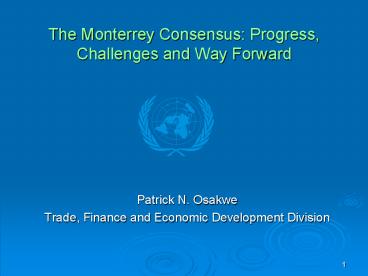The Monterrey Consensus: Progress, Challenges and Way Forward - PowerPoint PPT Presentation
1 / 19
Title:
The Monterrey Consensus: Progress, Challenges and Way Forward
Description:
The Monterrey Consensus has now emerged as the key framework for development finance. ... Africa have increased since the adoption of the Monterrey Consensus. ... – PowerPoint PPT presentation
Number of Views:95
Avg rating:3.0/5.0
Title: The Monterrey Consensus: Progress, Challenges and Way Forward
1
The Monterrey Consensus Progress, Challenges and
Way Forward
- Patrick N. Osakwe
- Trade, Finance and Economic Development Division
2
I. Background
- The most important challenge facing Africa is how
to achieve sustained economic growth and
eradicate poverty - The 2007 MDG Report indicates that Africa is the
only region at risk of not meeting any of the
MDGs. - Mobilization of finance is crucial to reversing
the current trend and increasing the likelihood
of African countries meeting the MDGs by the
target date. - World leaders recognized the importance of
finance in meeting the MDGs when they adopted the
Monterrey Consensus in 2002
3
- The Monterrey Consensus has now emerged as the
key framework for development finance. It has six
core areas - Mobilizing domestic financial resources for
development - Mobilizing international resources for
development - Promoting international trade as an engine of
development - Increasing international financial and technical
cooperation for development - External debt
- Systemic issues
4
II. Tracking Performance and Progress
- A key question that the international community
has to answer is to what extent have the
objectives of the Monterrey Consensus been
achieved in the six core areas? - This presentation provides answers to this
question using two methods - Published macroeconomic data
- ECA survey of African policymakers
5
Evidence from Macroeconomic Data(annual average)
6
ECA Survey of Policymakers Key Messages
- Overall, very limited progress has been made in
realizing the objectives of the Monterrey
Consensus in the Africa region - Significant progress has been made in the area of
external debt relief. - But performance in the areas of international
trade as well as external and domestic resource
mobilization has been either fair or disappointing
7
Area of least progress in the Monterrey
Consensus( of respondents)
8
- FDI inflows have increased in recent years, but
they are still insufficient and too concentrated
in the natural resources sector - African governments have made efforts to mobilize
domestic savings, but savings ratio remain low
relative to investment requirements - 41 percent of respondents rated as good the
performance of domestic governments in mobilizing
savings - 28 percent rated it as fair
- 25 percent rated it as poor.
9
Obstacles to the mobilization of domestic
resources
10
- ODA flows to Africa have increased since the
adoption of the Monterrey Consensus. - But donors are still not on track to meet their
commitments and recent aid flows tend to be
concentrated in a few countries and social
sectors - Although exports have increased in recent years,
respondents believe that donors have not made
much progress in supporting African countries in
the area of trade - The main barriers to export promotion in the
region are market access and supply constraints
11
Barriers to export promotion and development
12
- On systemic issues, the international community
has not done enough to increase Africas voice in
the governance of international monetary,
financial and trading systems. - 56 percent of respondents disagreed with the
notion that the current governance structures
allow for effective participation of African
countries in the global economy. - In the area of external debt, majority of the
respondents (over 70 percent) agree that there
has been significant progress in reducing the
external debt of African countries. - However, 65 percent of the respondents do not
believe that recent debt relief initiatives will
lead to a resolution of the debt problem in
Africa.
13
Source of external debt problem in African
countries
14
III. The Way Forward
- Evidence from both macroeconomic data and ECA
survey of African policymakers suggest that very
limited progress has been made in achieving the
goals of the Monterrey Consensus - Considerable efforts are required by both African
governments and development partners to mobilize
the resources needed for development in the region
15
Domestic and International Resource Mobilization
- African countries need to take concrete actions
to boost savings by exploiting the potential of
micro-finance institutions, promoting regional
integration of capital markets, and aligning
trade reforms with fiscal policy responses. - They also need to improve the investment
environment, develop financial infrastructure,
and reduce transaction costs of remitting money
from abroad. - They should be selective in their choice of FDI
flows with preference for sectors with high-value
added.
16
International Trade
- African countries have to move into the export of
new and dynamic products in world trade if they
are to increase the regions share in global
exports. - Diversification of the production and export
structure is necessary to achieve this objective. - Development partners should create a trading
environment that allows the region to unlock its
export potential.
17
Official Development Assistance
- Africas development partners must scale up
efforts to meet their pledges on aid quantity and
quality. - They should also live up to their promise to
untie aid flows and make them more predictable. - There is also the need for better allocation of
aid across countries and sectors to maximize
impact
18
External Debt and Systemic Issues
- Despite progress in debt relief, there is the
need to extend eligibility for current debt
relief programmes to non-HIPC African countries. - African countries should also put in place a
mechanism to ensure that loans from new creditors
do not lead to a new cycle of indebtedness. - The international community should begin to take
more seriously the issue of increasing the voice
of African countries in decision making bodies of
international institutions.
19
THANK YOU

